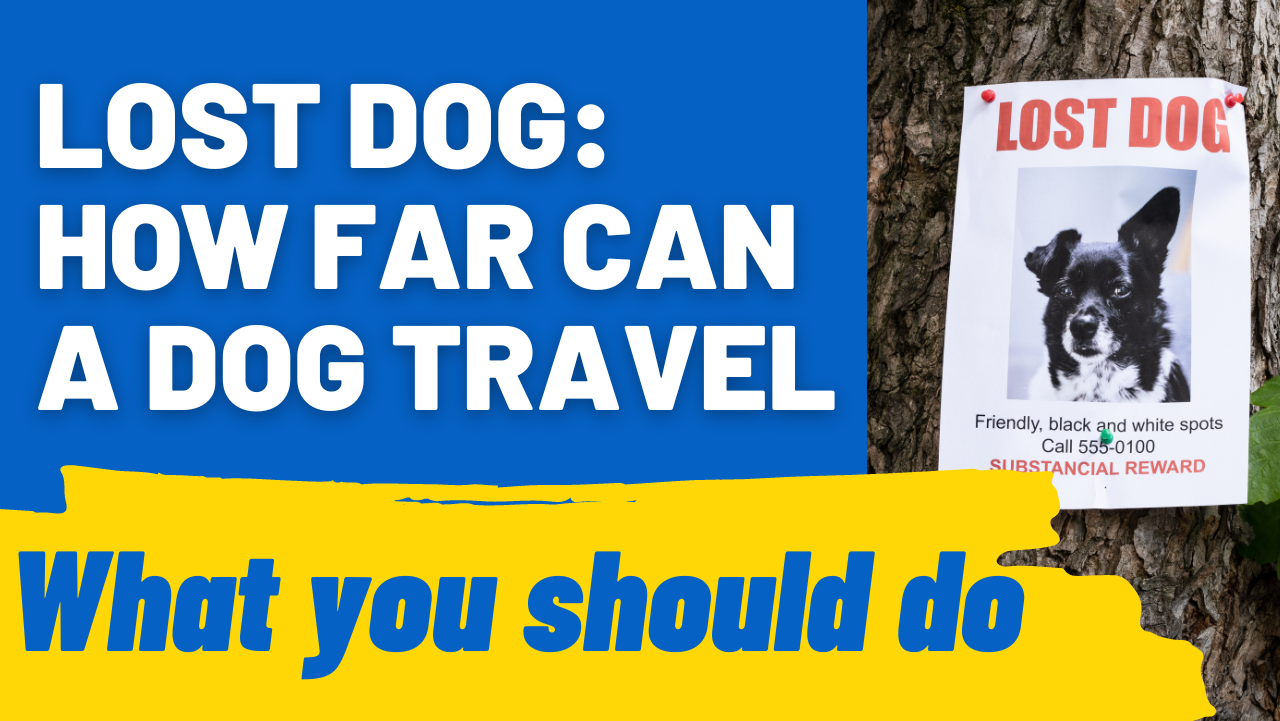Losing a dog can be stressful and upsetting. However, don’t lose hope. If your dog has run away then you need to come up with a search strategy.
Lost dogs are often found within a couple of miles of their last location. However, many variables can affect how far your dog can stray. Check out the information below to help with their safe return.

How Far Will a Lost Dog Travel in a Day
Your dog’s location can change by the minute, but two miles is a reasonable search radius after a dog has gone missing for one day. Additionally, other factors can help narrow down the search radius.
Take, for example, the size and health of your pet. A big dog in its prime has longer strides and can cover as much as five miles daily, whereas a smaller dog can travel only half a mile.
Additionally, expect to find less active, ill, or elderly dogs much closer to the area where they were last spotted.
Also, keep in mind that your dog won’t necessarily move in a straight path. It may double back during that stretch or change directions.
Something else to consider are population, terrain, and weather in your location.
Your dog can cover more ground if you live in a less-populated area with mostly flat terrain. In contrast, a busy neighborhood or hilly, rough terrain can prevent your pet from straying too far.
Cold and rainy weather are also deterrents to movement.
Another essential factor in how far your dog can travel is their temperament. This affects how they behave during their time away from home.
For instance, a friendly dog won’t shy away from humans and other animals. Thus, it’ll keep within shorter distances and, hopefully, increase its chance of being found.
On the other hand, a timid dog will be less comfortable with strangers, so they may keep moving to evade human contact. When they get tired, they may hide away to stay safe and out of sight.
Can Dogs Smell Their Owners From Miles Away?
Dogs have 220 million to 2 billion olfactory neurons compared to the 12–40 million neurons in humans. Obviously, this makes their sense of smell far superior to humans.
This enables dogs to smell their owners as far as 12 miles (20 km) away. However, this is achievable only if the dog has been trained on how to locate your scent. Plus, the wind needs to be in the right direction and warmer and dry weather helps too.
Can Dogs Find Their Way Home From Far Away
There are many accounts of dogs finding their way home from far distances. For example, Jimpa, a boxer and labrador cross, holds the Guinness World Record for walking 2000 miles across Australia to return home.
Some factors that make successful return journeys possible, such as this one, include:
Scent Markers
Dogs use scent markers to track places. Every time they set foot in an area, their paw pads leave behind distinct scents.
Then, the next time they get a whiff of that scent, chemical signals are sent to the brain as a reminder that this is a familiar location.
However, many experts believe these scents can last only up to two weeks. However, the smell may dissipate sooner in hot and dry conditions.
Visual Markers
Dogs don’t have the best vision, but they recognize visual markers. They use these to draw a mental map of places they’ve been.
When lost, they also help guide them through unfamiliar territories.
Magnetic Orientation
Studies suggest that dogs use magnetic fields for navigation. One demonstration of this concept was conducted in the Czech Republic.
During the experiment, researchers observed 27 dogs based on how they returned to their owners. Around 60% made their way back via the original path.
On the other hand, nine dogs responded differently. They ran along Earth’s north-south magnetic axis before taking a new route back to their owners.
What Do Dogs Do When They Are Lost?
Many lost dogs feel anxious being away from their owners. Their initial response will be to seek a safe place to stay, and eventually, food, water, and shelter will drive their movement.
Additionally, lost dogs will react according to their temperament, which the Missing Animal Response (MAR) has categorized into three types: gregarious, aloof, and xenophobic dogs.
Knowing which category your dog falls into means you can follow the right approach to ensure their safe return.
Gregarious Dogs
These dogs are friendly and even comfortable around strangers. Plus, they’re responsive to simple calls, which makes them easier to capture.
People who stumble across gregarious dogs may take it upon themselves to adopt them because they’re so social and loveable.
Aloof Dogs
Aloof dogs are wary of strangers, so they tend to travel farther distances to avoid humans. This behavior can make retrieval last for several weeks or months.
Yet, the problem is they’ll quickly begin showing signs of starvation and injury. So, while experienced rescue groups are more adept at handling situations like this, you can always try enticing them with food to gain their trust.
Xenophobic Dogs
These dogs have been through trauma in the past, making them less trusting. They quickly panic and get scared, which can lead to serious injuries from car accidents, falls, and bumps.
Hence, humane traps must be used to capture them and keep them safe. Other rescue dogs are also used in such cases to establish trust.
Chances of Finding a Lost Dog After 24 Hours

The first 24 hours are critical to finding your lost dog. Within that time frame, you stand a 93% chance of bringing them home.
After that, your odds decrease to about 60%. That’s why you must act swiftly, logically, and strategically once you realize your dog is missing.
Scour your property and nearby areas to ensure your dog is truly lost and not just hiding in your backyard. Then, take the necessary steps.
We recommend you get in your car and drive around in a two mile radius from your home calling their name. Drive slow. If they have a favorite squeaky toy, or love the sound of the kibble when you feed them, try and replicate that sound.
What Are the Chances of a Dog Finding Its Way Home?
The chances of a lost dog returning home is 16%. Of course, that depends on where it was last seen and how far it’s traveled.
The good news is that you can expect a higher chance of return if they disappeared in your neighborhood or another familiar place. It’ll be easier for it to recognize visual cues and scent markers.
Unfortunately, the farther they get, the less it’ll be able to circle back.
And if they ran away when they were off leash in unfamiliar territory, then your chances of finding them will also diminish.
Where Do Lost Dogs Go at Night?
Survival instincts are activated when a dog is lost. So, at night, they will likely look for a safe place to stay.
If your dog went missing not too long ago, they may be hiding in a familiar area. Check nearby parks or neighborhood yards that you frequently visit or pass by.
Additionally, your pet will seek shelter against the cold.
What Should I Do If I Lost My Dog?
You can do several things to bring your dog back home.
For starters, organize a team to do a local search. Friends and neighbors who are familiar with your pet can be a great help.
You’ll need to cover a 2-mile radius. Carry with you some of your dog’s possessions, like treats and toys.
Call their name in a friendly tone and use words they usually responds to.
Next, get the word out that your dog is missing. Take advantage of social media and ask friends to help spread the news.
Another good idea is to distribute and post flyers with a picture of your dog and your contact details.
Call shelters and breed rescue programs to see if there’s one that fits your dog’s description. Also, inform the local authorities.
If your dog has a microchip, notify the vet regarding your lost dog. Check if your address and phone numbers are updated, so finders can easily locate you.
Conclusion
How far can a dog travel when lost? This depends on your dog’s behavior, temperament, size, and overall health. Population density, terrain, and weather conditions in your area factor in as well.
More importantly, consider the time from when your dog went missing. An immediate search is necessary to increase your chances of finding it before it gets too far.
One thing is for sure: your furry friend is also out there looking for you. So, don’t lose hope in their ability to find their way back home to you.




